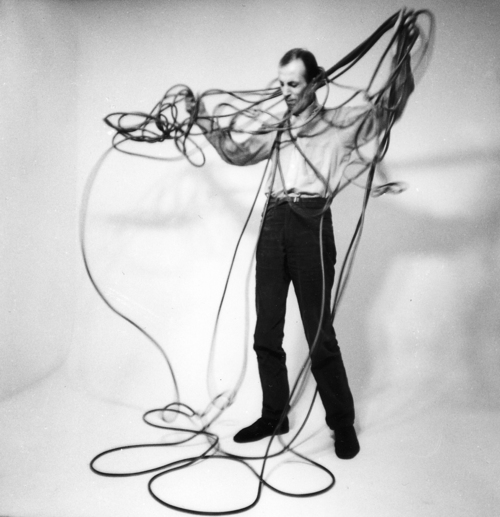Edward Krasinski
dal 10/5/2006 al 26/8/2006
Segnalato da
10/5/2006
Edward Krasinski
Generali Foundation, Wien
Retrospective. Dark rooms with sculptures, enhanced by lighting effects; labyrinthine architectures and pedestals on which performative objects are arranged; the artist as actor who stages himself and his works in front of the camera, also thematizing his own creation.

The Generali Foundation is devoting a retrospective to Edward Krasinski, one of the
most important protagonists of the Polish neo-avant-garde from the 1960s and 1970s.
It is the first retrospective to take place since the artist passed away in 2004.
Dark rooms with sculptures, enhanced by lighting effects; labyrinthine architectures
and pedestals on which performative objects are arranged; the artist as actor who
stages himself and his works in front of the camera, also thematizing his own
creations …
This exhibition focuses on Edward Krasinski’s unique exhibition designs, grandiose
settings for his works for which he transformed the respective spaces into
completely new spatial situations. The retrospective will also feature the
first-ever comprehensive display of the (self-) representations that Krasinski
created, often in collaboration with the photographer Eustachy Kossakowski. One
series of these remarkable works was already included in the exhibition COLLECTED
VIEWS FROM EAST OR WEST at the Foundation in 2004. At the same time, reference will
be made to one of the main locations of his work, the legendary Foksal Gallery in
Warsaw, which he helped to found in 1966. Important exhibitions are reconstructed -
including, for the first time, his contribution to the 1970 Tokyo Biennial. During
the research for the retrospective exhibition, several works were found whose
whereabouts had been unknown up to then and that are now being shown again for the
first time.
Rooted in Surrealism and Constructivism, Edward Krasinski (born 1925 in ?uck in what
is today Ukraine) in the mid-1960s produced sculptures that are virtually reduced to
a line. Quite early he developed conceptual strategies: at the end of the 1960s, he
discovered for himself a standard, commercial, blue adhesive tape that he henceforth
attached to various surfaces, always at a height of 130 cm - a standardized “scotch
tape," and at the same time the artistic marking for which he is known today. When
the artworks for his exhibition at the 1970 Tokyo Biennial did not arrive, he sent
the word “BLUE" 5000 times by telex, and exhibited this text on the long paper
strip. In Paris, accompanied by concept art pioneer, Daniel Buren, he pasted the
blue tape on the walls of the courtyard of the municipal Museum of Modern Art and on
the windows of the Rive Gauche art galleries. Even during the communist regime in
Poland, Krasinski’s works were shown at international exhibitions early on
, including in New York.
An important field of work is his studio, which Edward Krasinski took over from the
Polish constructivist Henryk Stazewski, at first sharing it with him. From 1988 he
then turned it into his own artistic environment, making it again the subject of his
works. At the same time, the studio functioned as an important communications centre
- in the 1990s he had increasing contact with young artists from Poland and abroad.
With humour and irony, Edward Krasinski created a heterogeneous and complex body of
works that oscillates between painting, sculpture and installation art, covering
performative and conceptual aspects.
Artistic and Managing Director, Curator: Sabine Breitwieser
Assistant-Curator, Exhibition Co-ordination: Bettina Sporr
Opening: 11 May 2006, 7 p.m.
Generali Foundation
Wiedner Hauptstrasse 15 - Wien



